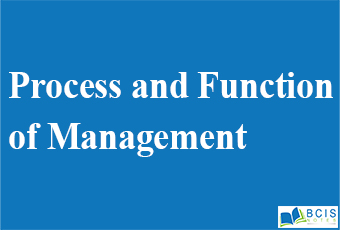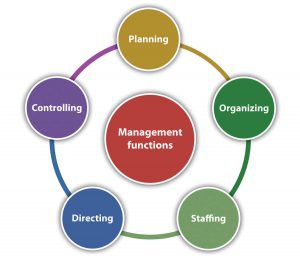
Management Process
Management process is those function which is performed by a manager are known as a management process. The process of management thus refers to a series of inter-related functions. It is the process by which management creates, operates and directs purpose organization through systematic, coordinated and co-operated efforts. In other words, the management process suggests the function to be performed by managers for achieving specific objectives.
It is a systematic way of doing managerial activities like Planning, Organization, Directing, Controlling and Decision Making. Management Processes are also termed as organizational processes because they go beyond an individual manager and affect the entire organization.
According to George R. Terry, “It is a distinct process consisting of planning, organization, actuating, and controlling, performed to determine and accomplish stated objective by the use of human beings and others resources.”
The management process, as seen above, suggest that all managers perform certain functions in order to realize certain goals. As a process, management consists of the following five aspects:
- MANAGEMENT AS A SOCIAL PROCESS: Since the human factor is most important among the other factors, therefore management is concerned with developing relationships among people. It is the duty of management to make the interaction between people – productive and useful for obtaining organizational goals.
- MANAGEMENT AS A INTEGRATION PROCESS:
It is a collection of the process required to ensure that the various elements of the projects are properly coordinated. It involves making trade-offs among competing objectives and alternatives to meet or exceed stakeholder needs and expectations. It is Comprised of project plan development. - MANAGEMENT AS A CONTINUOUS PROCESS:
It is a never-ending process. It is concerned with constantly identifying the problem and solving them by taking adequate steps. It is an on-going process. - MANAGEMENT AS A GOVERNANCE PROCESS:
It is a major issue, and yet often forgotten and overlooked by organizations. In short, we can say that process governance is the way in which a company can consolidate the process management initiatives within standards, rules, and guidelines that all go together towards a common goal. - MANAGEMENT AS A UNIVERSAL PROCESS AND PHENOMENON:
Management is a universal phenomenon in the sense that it is a common and essential element in all enterprises. Every group effort requires setting objectives, making plans, handling people, co-coordinating and controlling activities, achieving goals and evaluating performance directed towards organizational goals.
Function of Management
Management in some form or another is an integral part of living and is essential wherever human efforts are to be undertaken to achieve desired objectives. The basic ingredients of management are always at play, whether we manage our lives or business. Management is a set of principles relating to the functions of planning, organizing, directing, and controlling. Management is essential for an organized life and necessary to run all types of organizations.

There are basically five primary functions of management. They are as follow:
- Planning
- Organizing
- Staffing
- Directing
- controlling
1. Planning: Planning is an important function of management. It is the process of determining mission, goals, and targets, and the activities necessary to achieve them. Planning formulates the organization’s future courses of action. Organization plans contain the schedule of activities and show the allocation of resources for reaching goals and objectives.
According to Peter Drucker,” Planning is the continuous process of making present entrepreneurial decisions systematically and with best possible knowledge of their futurity, organizing systematically the efforts needed to carry out these decisions and measuring the results of these decisions against the expectations through organized and systematic feedback.”
The internal factors that affect planning are limited growth opportunities due to saturation requiring diversification, changing patterns of the workforce, more complex organizational structures, decentralization, etc.
2. Organizing: The second of the managerial functions is organizing. This step requires Melissa to determine how she will distribute resources and organize her employees according to the plan. Melissa will need to identify different roles and ensure that she assigns the right amount of employees to carry out her plan. She will also need to delegate authority, assign work, and provide direction so that her team of sales representatives can work towards higher sales numbers without having barriers in their way.
According to Henry Fayol,” To organize a business is to provide it with everything useful or its functioning i.e. raw material, tools, capital and personnel’s.” To organize a business involves determining & providing human and non-human resources to the organizational structure. Organizing as a process involves:
- Identification of activities.
- Classification of a grouping of activities.
- Assignment of duties.
- Delegation of authority and creation of responsibility.
- Coordinating authority and responsibility relationships.
3. Staffing: The staffing function is an increasingly important function of management, although it is sometimes left out when the core functions are discussed. It can be seen closely related to organizing, with both focused on ensuring the resources are directed to the right processes and tasks. For staffing, the focus is on people and their labor in relation to the organizational objectives.
The function aims to ensure the organization always has the right people in the right positions and the organizational structure isn’t hindered by lack or excess of personnel. You would essentially be looking at the tasks ahead of you and determining who should do what and if you have the right manpower to achieve the objectives you want.
According to Kootz & O’Donnell, “Managerial function of staffing involves manning the organization structure through the proper and effective selection, appraisal & development of personnel to fill the roles designed on the structure”.
Staffing involves:
- Manpower Planning (estimating manpower in terms of searching, choose the person and giving the right place).
- Recruitment, Selection & Placement.
- Training and Development.
- Remuneration.
- Performance Appraisal.
- Promotions & Transfer.
4. Directing: Directing is about the actuation of the methods to work efficiently to achieve the set organizational objectives. The function goes beyond organizing the employees to their specific roles and involves ensuring they are able to perform the tasks through a variety of means. Directing, in essence, is looking after productivity and ensuring productivity is going up instead of decreasing. The function of directing has strong links to things such as leadership. A good manager will be able to inspire the workforce to work towards the goals not because they have to do it, but because they are driven to achieve these objectives.
Directing has an important role in an organization as it helps strengthen the operational capability of the organization. It does so by ensuring the different parts of the organization are working better. Directing is a bridge between the operational needs and the human requirements of its employees.
Directing has an important role in an organization as it helps strengthen the operational capability of the organization. It does so by ensuring the different parts of the organization are working better. Directing is a bridge between the operational needs and the human requirements of its employees.
Directing has an important role in an organization as it helps strengthen the operational capability of the organization. It does so by ensuring the different parts of the organization are working better. Directing is a bridge between the operational needs and the human requirements of its employees.
You can direct and lead your team by utilizing four key methods based on the findings of human behavioral studies. These are:
- Supervision
- communication
- Motivation
- Leadership
5. Controlling: The function ensures the other four functions are followed correctly and the flow of work is moving the organization towards the objectives it has set itself. The activities consist of establishing standards for work performance, measuring performance and comparing it to these set standards and taking corrective actions as and when needed, to correct any deviations.
According to Koontz & O’Donnell, “Controlling is the measurement & correction of performance activities of subordinates in order to make sure that the enterprise objectives and plans desired to obtain them as being accomplished.”
The controlling function involves:
a. Establishment of standard performance.
b. Measurement of actual performance.
c. Measuring actual performance with the pre-determined standard and finding out the deviations.
d. Taking corrective action.
you may also like Managerial hierarchy and level

Leave a Reply